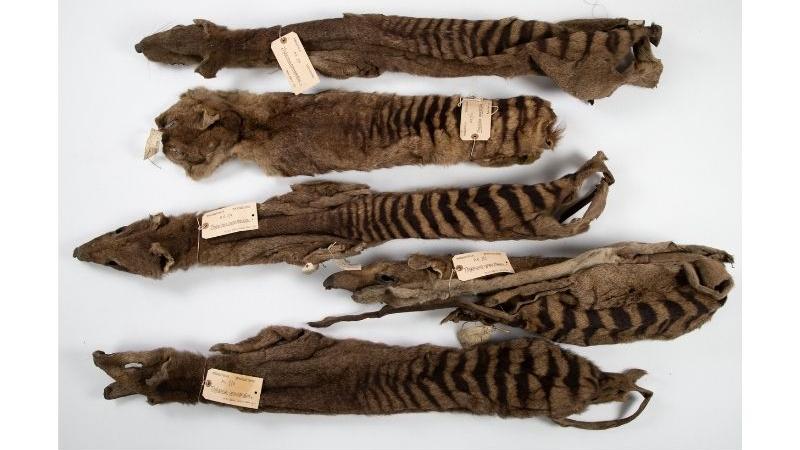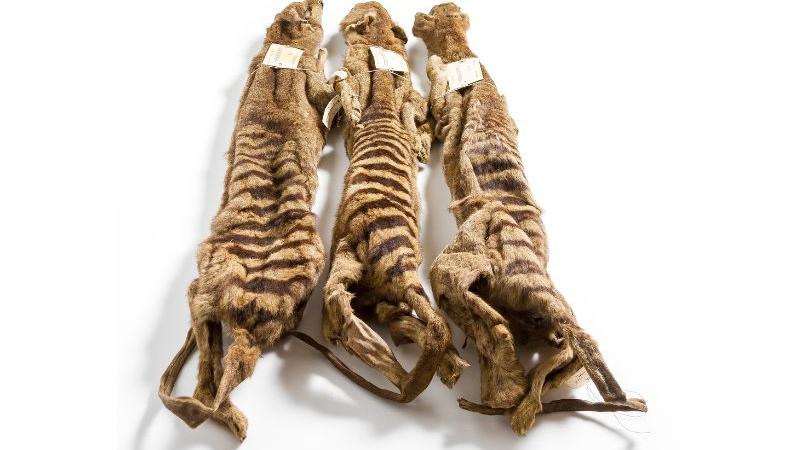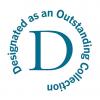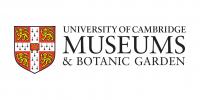What’s in the collection?
The largest collection of thylacines in the UK, if not the world, known to originate from a single collector. Thylacines are large extinct marsupial carnivores. As the specimens in Cambridge have hardly been exposed to light, their striped pattern has been perfectly preserved.
Alongside the nine thylacines are around 30 other Tasmanian mammals donated by Morton Allport, and eleven Australian birds.

When did it arrive?
1869 and 1871
What do we know about the specimens in Cambridge?
These specimens represent both the human and the environmental cost of the colonial project, and demonstrate how these costs were deeply entwined with practices of natural history.
Please be aware that the below includes reference to racial violence against First Nations Australian people.
The invasion of Tasmania by European colonists began in 1803. Quickly, these colonists perceived both the thylacines and the Indigenous human population as a threat to the successful development of the colony. Thylacines were accused of killing sheep, however we now know that they could not have had an impact on the farming industry, and in fact the colonists’ kangaroo-hunting dogs were to blame for most sheep losses. And as the colonists dispossessed Aboriginal people of their land to farm on, and hunted kangaroos on which Indigenous diets relied for protein, conflict grew between the two populations.
These issues ultimately led to the systematic state-sponsored persecution of both Indigenous Tasmanians and thylacines. Bounties were first established for killing both in 1830. The eventual outcome was the extinction of the thylacine and genocide against the peoples. (Although they were unsuccessful, the British aimed to extirpate Tasmania’s Indigenous population, justifying the use of the term “genocide”).
We should not consider them to be equivalents, but there are several parallels between the treatment and representation of thylacines and Indigenous Tasmanian people, and how their remains were traded.
A central figure in the export of both thylacines and Indigenous remains from Tasmania was Morton Allport. The Colonial histories of Australian mammal collections in Cambridge project has shown how Allport actively built a scientific reputation by exchanging specimens for honours. Alongside many other Tasmanian mammals, Allport sent more thylacine specimens to European museums than anyone else. He also identified himself as the principal exporter of the bodily remains of Tasmanian Aboriginal people to Europe. He achieved this through grave-robbing and by mutilating people’s bodies after their deaths. He was involved in the exhumation and mutilation of William Lanne’s remains, who at the time was considered by settler colonists to be the “last male Aboriginal Tasmanian” – and as such Allport and others viewed him as a valuable “specimen”. Allport obtained Lanne’s skeleton for the Royal Society of Tasmania, and tried and failed to locate his skull, after it was stolen by William Crowther – another of the Museum’s donors.
As the populations of both thylacines and Aboriginal people decreased through colonial violence and persecution, Allport offered to send European and other institutions their remains if, in turn, they made him a fellow of elite learned societies. He emphasised their increasing rarity and the difficulty of acquiring them in order to engender an increased sense of obligation from those receiving his donations. Allport’s zoological specimens are now in the University Museum of Zoology, Cambridge; the Royal Belgian Institute of Natural Sciences (RBINS), Brussels; and the Natural History Museum, London; as well as in Australian museums. He sent the skeletons of Tasmanian Indigenous people to the Royal College of Surgeons, England; the Anthropological Society of London; RBINS and the private collector Joseph Barnard Davis.
The Cambridge specimens, including twelve thylacines (of which nine remain, including five skins), arrived in 1869 and 1871, sent to Alfred Newton at the Museum as a donation. Allport did not collect specimens himself, but had a series of rural contacts who provided material for him. We cannot identify who was responsible for which specimens.

Who was Morton Allport?
Allport was born in Staffordshire, England, in 1830, but at six months old his family emigrated to Hobart, Tasmania. His father Joseph Allport (1800-1877) became one of the colony’s most distinguished solicitors. Morton joined his firm and subsequently become partner, although his true passion was for natural history. He was active in the Royal Society of Tasmania (RST) from 1849 and served as vice-president from 1870 until his death in 1878.
Allport was involved with many colonial enterprises in Tasmania. He worked tirelessly in the field of acclimatisation – the introduction of non-native species for the supposed “improvement” of local ecosystems – a practice that has had devastating environmental consequences. He introduced tench, perch and water lilies from England to Tasmania, and did much to get salmon and trout established there. Allport was also involved in the extractive industries, with stakes in several Tasmanian mining prospects.
Allport corresponded about contemporary scientific issues with several eminent naturalists in Europe, including John Gould. Allport subscribed to the colonial assumption that marsupials were declining as a consequence of being inherently “lower” than European mammals . This view was widespread, and can be viewed in the context of European racism, as racial hierarchies had been similarly fabricated.
When Allport died, his obituarist described him as:
“conspicuous as the foremost scientist in the colony and it is only necessary to turn to his name in the list of vice-presidents of the Royal Society of Tasmania to see how fully his scientific attainments have been recognised by various English and Foreign societies, who have elected him an honorary member of their body.” (Anonymous 1878)
Allport’s letters show he had invested heavily in developing this reputation, particularly regarding recognition from scientific societies. However, it was less Allport’s “scientific attainments” that led to the awarding of honours, than his investment in supplying valuable specimens, including of thylacines and Tasmanian Aboriginal people, as described above.
Further Reading
Ashby, J. (in press, 2023). How collections and reputation were built out of Tasmanian violence: thylacines and Aboriginal remains from Morton Allport. Archives of Natural History 50(2).
References
Anonymous, 1869 Telegraphic despatch. Launceston Examiner, 16 March, p.3.





